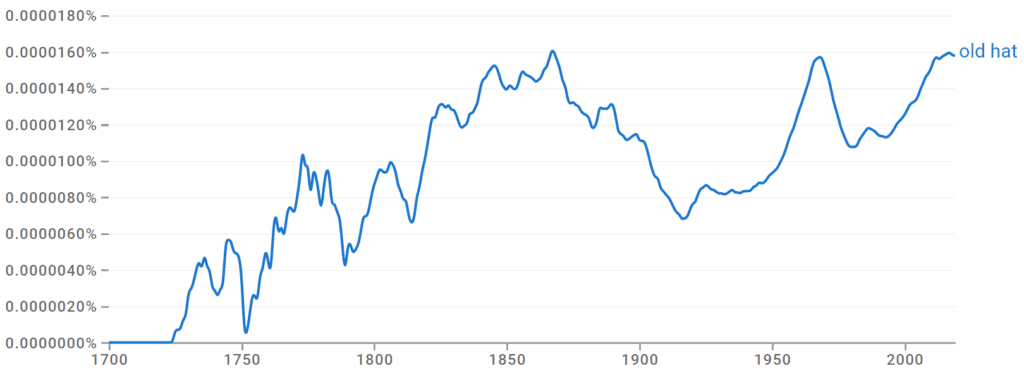Idioms are a unique addition when you want to add a figurative flair to your speech and writing. However, they can also be quite confusing if your audience is unfamiliar with their origins.
Idioms mean something different than their literal use. They often offer added detail and explanation through allusion and symbolism to help an audience connect with your message—but only as long as they recognize the source.
The phrase old hat is an idiom with a rather interesting and risque origin. Today, it is absolutely G-rated, but its interesting history is worth understanding so you can understand its use in various contexts.
What Is the Meaning of the Phrase Old Hat?

When you use the idiom old hat, you infer that something is out of date, old-fashioned, or worn out due to repeated use and familiarity—making it uninteresting, predictable, or tritely familiar.
For example:
- I suppose that joke is old hat by now since everybody groans when she opens her mouth to tell it.
- Directing successful RomComs is old hat to him; after all, he has a slew of awards under his belt for his eye for detail.
- Remakes are so old hat. Why can’t they come up with something original?
- Don’t you think that overcoat is a bit old hat, and a trip to the store for something a bit more modern is in order?
- His comedy may be old hat to the younger generations, but those who grew up listening to him still tune in for a good laugh.
The term itself is somewhat old hat in that it is fairly antiquated in its use. Although the idiom is recognized, it is not common modern jargon and is rarely seen in more recent publications.
Old Hat Origin

The term old hat to mean “out-of-date” first appeared in the early 1900s as an allusion to a beat-up felt hat that shows its wear due to its repeated use. It is seen in the publication in the UK of the novel Brother Copas, published in 1911, when a character states,
- “And the difference is not that religion has ceased to teach it – for it hasn’t – but that men have grown decent and put it, with like doctrines, silently aside in disgust. So it has happened with Satan and his fork: they have become ‘old hat.'”
Interestingly, old hat had an earlier meaning, popular in the late 1600s to the late 1700s. At that time, old hat referred to a woman’s private anatomy. The term was taken from a bawdy joke. Today, this meaning is utterly forgotten, and old hat is only used to mean old-fashioned or worn out through familiarity (perhaps as a nod to its original use).
It was first referenced in Thomas D’Urfey’s comic play The Intrigues at Versailles, published in 1697:
- “Why, how now, ye piece of old Hat, what are ye musty? the Jade’s as musty as a stale pot of Marmalade of her own making.”
George Grose lists it in his 1785 publication of the Classical Dictionary of the Vulgar Tongue as “Old hat; a woman’s privities: because frequently felt.”
But, by the time Mr. Grose recorded it as such, it had already taken on a less bawdy use, and few publications have ever referred to it in such a manner since.
Let’s Review
Despite its bawdy inception, old hat is an idiom synonymous with old-fashioned, out-of-date, or simply worn out with familiarity. Its original definition hasn’t been used since the very early 19th century, making it a safe enough term to use without fear of embarrassment. However, it is fairly old-fashioned in its use itself and is rarely seen in modern publications.
